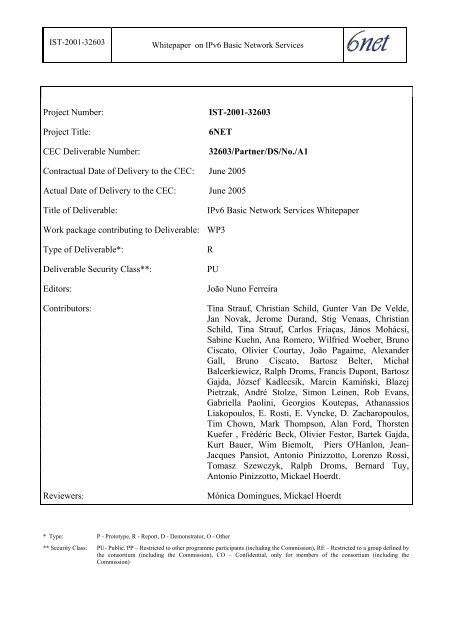IPv6 Basic Network Services Whitepaper published - 6NET
IPv6 Basic Network Services Whitepaper published - 6NET
IPv6 Basic Network Services Whitepaper published - 6NET
You also want an ePaper? Increase the reach of your titles
YUMPU automatically turns print PDFs into web optimized ePapers that Google loves.
IST-2001-32603<br />
<strong>Whitepaper</strong> on <strong>IPv6</strong> <strong>Basic</strong> <strong>Network</strong> <strong>Services</strong><br />
Project Number:<br />
Project Title:<br />
CEC Deliverable Number:<br />
IST-2001-32603<br />
<strong>6NET</strong><br />
32603/Partner/DS/No./A1<br />
Contractual Date of Delivery to the CEC: June 2005<br />
Actual Date of Delivery to the CEC: June 2005<br />
Title of Deliverable:<br />
<strong>IPv6</strong> <strong>Basic</strong> <strong>Network</strong> <strong>Services</strong> <strong>Whitepaper</strong><br />
Work package contributing to Deliverable: WP3<br />
Type of Deliverable*:<br />
Deliverable Security Class**:<br />
Editors:<br />
Contributors:<br />
Reviewers:<br />
R<br />
PU<br />
João Nuno Ferreira<br />
Tina Strauf, Christian Schild, Gunter Van De Velde,<br />
Jan Novak, Jerome Durand, Stig Venaas, Christian<br />
Schild, Tina Strauf, Carlos Friaças, János Mohácsi,<br />
Sabine Kuehn, Ana Romero, Wilfried Woeber, Bruno<br />
Ciscato, Olivier Courtay, João Pagaime, Alexander<br />
Gall, Bruno Ciscato, Bartosz Belter, Michał<br />
Balcerkiewicz, Ralph Droms, Francis Dupont, Bartosz<br />
Gajda, József Kadlecsik, Marcin Kamiński, Blazej<br />
Pietrzak, André Stolze, Simon Leinen, Rob Evans,<br />
Gabriella Paolini, Georgios Koutepas, Athanassios<br />
Liakopoulos, E. Rosti, E. Vyncke, D. Zacharopoulos,<br />
Tim Chown, Mark Thompson, Alan Ford, Thorsten<br />
Kuefer , Frédéric Beck, Olivier Festor, Bartek Gajda,<br />
Kurt Bauer, Wim Biemolt, Piers O'Hanlon, Jean-<br />
Jacques Pansiot, Antonio Pinizzotto, Lorenzo Rossi,<br />
Tomasz Szewczyk, Ralph Droms, Bernard Tuy,<br />
Antonio Pinizzotto, Mickael Hoerdt.<br />
Mónica Domingues, Mickael Hoerdt<br />
* Type: P - Prototype, R - Report, D - Demonstrator, O - Other<br />
** Security Class: PU- Public, PP – Restricted to other programme participants (including the Commission), RE – Restricted to a group defined by<br />
the consortium (including the Commission), CO – Confidential, only for members of the consortium (including the<br />
Commission)
IST-2001-32603<br />
<strong>Whitepaper</strong> on <strong>IPv6</strong> <strong>Basic</strong> <strong>Network</strong> <strong>Services</strong><br />
Abstract:<br />
A short and concise description of the <strong>IPv6</strong> development status is given, focusing on the <strong>Basic</strong> <strong>Network</strong><br />
<strong>Services</strong> that were included in Workpackage 3 of the <strong>6NET</strong> project.<br />
Keywords:<br />
<strong>IPv6</strong>, Routing, Multicast, DHCP, RPSLng, Renumbering, Security.<br />
2
IST-2001-32603<br />
<strong>Whitepaper</strong> on <strong>IPv6</strong> <strong>Basic</strong> <strong>Network</strong> <strong>Services</strong><br />
Executive Summary<br />
As the <strong>6NET</strong> project approaches its end, a great deal of knowledge was accumulated in the project<br />
Deliverables. Most of this Deliverables are extensive and much focused on one or two particular<br />
<strong>IPv6</strong> issues. It was recognized that for those interested in having a quicker reading about the present<br />
status of all those issues, it would be very useful to have a higher-level and shorter, set of<br />
documents. This <strong>Whitepaper</strong> attempts to fulfil that goal in respect to the <strong>Basic</strong> <strong>Network</strong> <strong>Services</strong><br />
targeted in Workpackage 3 of the <strong>6NET</strong> Project.<br />
It was also considered important to produce a broader view of all the important achievements<br />
attained in <strong>IPv6</strong>, that sometimes are not adequately emphasised as all efforts continuously move on<br />
in the quest for solving the remaining open issues.<br />
3
IST-2001-32603<br />
<strong>Whitepaper</strong> on <strong>IPv6</strong> <strong>Basic</strong> <strong>Network</strong> <strong>Services</strong><br />
Table of Contents<br />
1. INTRODUCTION................................................................................................................................................... 5<br />
2. ROUTING................................................................................................................................................................ 6<br />
3. DNS AND DHCPV6................................................................................................................................................ 6<br />
4. REGISTRY (RPSLNG) .......................................................................................................................................... 8<br />
5. MULTICAST .......................................................................................................................................................... 8<br />
6. SECURITY.............................................................................................................................................................. 9<br />
7. RENUMBERING.................................................................................................................................................... 9<br />
8. CONCLUSION...................................................................................................................................................... 11<br />
4
IST-2001-32603<br />
<strong>Whitepaper</strong> on <strong>IPv6</strong> <strong>Basic</strong> <strong>Network</strong> <strong>Services</strong><br />
1. Introduction<br />
After more than three years of work, the <strong>6NET</strong> project achieved several important goals. In the <strong>IPv6</strong><br />
<strong>Basic</strong> <strong>Network</strong> <strong>Services</strong> (BNS) area the progresses made during this period was remarkable. BNS<br />
are the building blocks of any network infrastructure. They remain mostly invisible for the end user,<br />
but it’s where most of the times issues like complexity, scalability and interoperability come to play<br />
a central role.<br />
Workpackage 3 (WP3) was divided in five sub-areas, to which a sixth was added later:<br />
1. Routing<br />
2. DNS and DHCP<br />
3. Regisrtry (RPSLng)<br />
4. Multicast<br />
5. Security<br />
6. Renumbering<br />
In this <strong>Whitepaper</strong> we followed the same division to present the main conclusion in each one of<br />
these areas. References to the corresponding deliverables were included at the end of each section.<br />
5
IST-2001-32603<br />
<strong>Whitepaper</strong> on <strong>IPv6</strong> <strong>Basic</strong> <strong>Network</strong> <strong>Services</strong><br />
2. Routing<br />
In the first six months of the project an enormous effort has been made to build up the <strong>6NET</strong><br />
network. In 35 locations Cisco routers have been installed, the national, backbone and local loops<br />
have been ordered and tested; the routing and addressing plan has been implemented and deployed.<br />
In the second half year, with beginning of August, almost all NREN and Universities were<br />
connected to <strong>6NET</strong>, based on native <strong>IPv6</strong> connections.<br />
In addition to the original 31 <strong>6NET</strong> partners, four new partners (PSNC, CESNET, Hungarnet and<br />
ETRI) joined the project on 1 st September 2002, as well as FCCN later in 2003. To incorporate the<br />
new partners, the network has been extended with <strong>IPv6</strong> tunnels to Poland, the Czech Republic,<br />
Hungary and Portugal. Moreover, the geographical coverage of the network and with it the scope of<br />
the activities has been broadened by connecting <strong>6NET</strong> to other research networks in Europe, North<br />
America and Asia. <strong>6NET</strong> provides connectivity for example to EURO6IX, 6BONE, Abilene and<br />
NTT. Although <strong>6NET</strong> is a test-bed network, one of the major requirements was to keep the network<br />
stable. Special maintenance and test windows within the network core have been defined to realise<br />
that.<br />
Apart from the operation of such a large continent-wide <strong>IPv6</strong> network, a separate task was<br />
developed to gather implementation status knowledge on:<br />
• Router Advertisements<br />
• Neighbour Discovery<br />
• RIPng<br />
• IS-IS<br />
• OSPF<br />
• BGP<br />
It was found that all these protocols are available today in several manufacturers in production<br />
stable version provided with maintenance.<br />
The knowledge and confidence gained in <strong>6NET</strong> enabled the anticipation of the launch of GEANT<br />
<strong>IPv6</strong> Unicast Service, in October 2003. Since then this service has been operated in a dual-stack<br />
mode to all NRENs connected to it. In April 2004, Class-of-Service (CoS) was successfully<br />
implemented in the <strong>6NET</strong> backbone, further enriching the complexity of the <strong>IPv6</strong> routing function.<br />
We are confident in reaching the conclusion that Routing can be regarded as one of the most well<br />
developed, tested, interoperable and available <strong>IPv6</strong> areas.<br />
For more information on the design and operation of the <strong>6NET</strong> backbone, see Deliverables D3.1.1<br />
and D1.5.x.<br />
For more information on configuring Routing in several equipments, see Deliverable D3.1.2.<br />
3. DNS and DHCPv6<br />
At the time of <strong>6NET</strong> planning DNS and DHCP were grouped together. Later it became evident that<br />
most of the work was to be done in the DHCP part rather than the DNS one.<br />
3.1. DNS<br />
The DNS service is a corner stone of any IPv4 or <strong>IPv6</strong> network. As <strong>IPv6</strong> uses the same hierarchy as<br />
IPv4, the dual-stack behaviour of this service is central to have a smooth operation and integration<br />
of both protocols.<br />
6
IST-2001-32603<br />
<strong>Whitepaper</strong> on <strong>IPv6</strong> <strong>Basic</strong> <strong>Network</strong> <strong>Services</strong><br />
After the setup and operation of the first set of services early on the first year of the project, namely<br />
DNS forward and DNS reverse, it was envisaged that DNSSEC would be added in the <strong>6NET</strong><br />
backbone. But this suffered a considerable delay regarding its initial plan. Two set of problems<br />
caused this. Firstly, although it was initially included in the Description of Work, as the project<br />
progressed it became clear that the usefulness of dealing with DNSSEC issues in an <strong>IPv6</strong> project<br />
like <strong>6NET</strong> was questionable.<br />
Secondly and more important, the DNSSEC standard that was stable at the beginning of the project<br />
proved in several trials to have severe practical implementation problems and soon the work on an<br />
alternative and better standard started. The schedule of this second standard, which is incompatible<br />
with the previous one, slipped forward in time, until by the end of 2003 when the Project Review<br />
was done it was still not available.<br />
The decision was then to either wait until new and updated DNSSEC software became available or<br />
write down these difficulties together with an implementation plan for a future implementation of<br />
DNSSEC in <strong>6NET</strong>. The second option was chosen and when the new DNSSEC standard<br />
implementation was available, in the second quarter of 2004, it was installed and successfully tested<br />
in the <strong>6NET</strong> backbone. That proved the expected isolation between DNSSEC and <strong>IPv6</strong>.<br />
Most important was the decision to allow <strong>IPv6</strong> glue records for ccTLD in the root-servers. Soon<br />
after this became possible, in the 2 nd quarter of 2004, dozens of ccTLD asked for the insertion of<br />
these records. This enables the creation and operation of fully compliant <strong>IPv6</strong> DNS domains.<br />
For more information on configuring DNS see Deliverables D3.1.2 and D3.2.1.<br />
3.2. DHCPv6<br />
After many years of work, DHCPv6 was <strong>published</strong> as RFC 3315. Despite the existence of stateless<br />
autoconfiguration for <strong>IPv6</strong> (RFC 2462), there is still a need for DHCP. On one hand, it<br />
complements stateless autoconfiguration where it can supply hosts with DNS, NTP and other<br />
configuration data. On the other hand, a network administrator might want to gain more control<br />
over the IP addresses used than what is possible with stateless address configuration. A stateful<br />
DHCPv6 implementation as of RFC 3315 offers both. In addition, the IETF DHC working group<br />
<strong>published</strong> a more lightweight respective "stateless" DHCPv6 version (RFC 3736), which serves<br />
only as a source for configuration options that are not already delivered to the host with stateless<br />
autoconfiguration.<br />
The stateless mode of DHCPv6 and especially the prefix delegation and nameservice option are<br />
more widely implemented as they seem to be more important for today’s networks. To the<br />
knowledge of the authors prefix delegation and nameservice option should work fine for most<br />
implementations. The lack of DHCPv6 relays is not so important in the stateless mode, as one could<br />
set up a DHCPv6 server on every link’s router. So at least the stateless feature sets seem to be<br />
deployable today.<br />
Speaking of address delegation with DHCPv6, the implementations mostly seem to be immature. In<br />
addition, the implementations do not interoperate properly. Obviously there has to take place more<br />
interaction between the different developers. So from a today’s point of view, stateful DHCPv6<br />
service is not deployable or at least only with some limitations. But there were giant steps since the<br />
beginning of <strong>6NET</strong>. So it seems that there will be a complete implementation in the near future for<br />
the major operating systems.<br />
7
IST-2001-32603<br />
<strong>Whitepaper</strong> on <strong>IPv6</strong> <strong>Basic</strong> <strong>Network</strong> <strong>Services</strong><br />
For more information on configuring DHCPv6 see Deliverable D3.2.3.<br />
4. Registry (RPSLng)<br />
The Internet is the interconnection of many independently managed networks. Each network is a<br />
domain with its own policies about internal and external relationships. The protocol used to<br />
exchange routing information between domains, also known as «Autonomous Systems» (AS), is the<br />
Border Gateway Protocol version 4. The Multiprotocol Extensions to BGP (MP-BGP) are widely<br />
implemented and deployed today, mainly for IPv4 multicast, <strong>IPv6</strong> unicast, and BGP/MPLS VPNs.<br />
Deployments for <strong>IPv6</strong> multicast are also starting to show up, mainly in the Research & Education<br />
<strong>Network</strong>s’ environment.<br />
The exchange of BGP routes between ASes is constrained by policies. Operators have the<br />
possibility to document their routing policies in their regional routing registry. In Europe the<br />
Regional Internet Registry is RIPE, but alternative routing data repositories also exist (RADB is an<br />
example). The language, that standardizes entries format in routing registries, has been defined in<br />
RFC 2622 - Routing Policy Specification Language and in RFC 4012 - RPSLng.<br />
The information in the Routing Registries can be used, above all, for automatic generation of BGP<br />
router configuration. Policy information can be documented in the registry at various levels of<br />
detail. The operators decide its policies and their level of publicity. Most upstream providers ask<br />
their customers to maintain routing registry data continuously up to date and consistent. Conditions<br />
can be relaxed in some Internet Exchange Points, especially for small organizations.<br />
After a long and slow development and testing phase, RPSLng has become a standard and it is<br />
active in the RIPE database. Although few operators have practical experience with the proposed<br />
RPSLng specification, it can be observed a growing number of RPLSng policies, as well as <strong>IPv6</strong><br />
addresses assignments by the LIRs to their end-users.<br />
Like IPv4 Routing Policies, <strong>IPv6</strong> routing policies need to be documented. Maintaining up-to-date<br />
routing policy information data should be a daily practice, but unfortunately often network<br />
administrators do not give it high priority, or decide that is better for them not to completely show<br />
their policy. The continuous maintenance of RPSLng tools projects should be a substantial<br />
contribution to the future implementation that we hope for the new version of routing policy<br />
language.<br />
For more information on configuring RPSLng see Deliverable D3.3.1<br />
5. Multicast<br />
Using unicast could result in sending the same message as many times to as many recipients there<br />
are. While using multicast, the message would be sent only once from the sender to the multicast<br />
group, the interested listeners. To achieve this, routers in a network, build a distribution tree. The<br />
advantages of multicasting are bandwidth demand reduction, server load decrease and less hardware<br />
requirements.<br />
Although reliability and congestion control can be built on top of UDP (and hence above the<br />
transport layer), there is still no generic mechanism and most multicast applications do not provide<br />
any congestion control today (which can be a real problem if multicast is widely used).<br />
8
IST-2001-32603<br />
<strong>Whitepaper</strong> on <strong>IPv6</strong> <strong>Basic</strong> <strong>Network</strong> <strong>Services</strong><br />
Multicast was one of the <strong>6NET</strong> areas with development work active until the end of the project. The<br />
project partners made a proposal for a new standard for <strong>IPv6</strong> Inter-Domain ASM: The Embedded-<br />
RP Solution, that’s already available in several router manufacturers. Some issues remain open with<br />
Embedded-RP, especially if the service is deployed in core networks, namely: Group address<br />
allocation, RP access control, RP robustness issues and RP securities issues.<br />
With the help of the expertise acquired, GEANT2 launched its pilot Multicast Service in the 1 st<br />
quarter of 2005.<br />
A multicast addressing study was also produced as well as a Deliverable regarding IPv4/<strong>IPv6</strong><br />
Multicast interoperability.<br />
For more information on Multicast, see Deliverables D3.4.x.<br />
6. Security<br />
<strong>IPv6</strong> is regarded worldwide as a solution for a number of the networking problems, the most<br />
important of which being IP address depletion. It also provides additional features that can enhance<br />
the network interconnection characteristics and security. Many of these new features however, have<br />
been untested in a real networking environment and could present novel challenges and threats.<br />
<strong>6NET</strong> started as a network for providing core <strong>IPv6</strong> connectivity, between European academic<br />
institutions. Since its successful implementation the focus has shifted from the basic (core)<br />
networking services to user connectivity and services. It's these services that provide the real value<br />
of the network and usefulness to the end users. Although in <strong>6NET</strong> the assets at risk are academic<br />
networks and the operation of experimental services, security problems can escalate to the<br />
universities’ internal networks, possibly creating problems there, but also may disrupt experiments<br />
and other evaluation processes of <strong>6NET</strong> itself. Furthermore, since <strong>6NET</strong> is also an important<br />
feasibility demonstration project, security will guarantee the public's trust in the value and<br />
especially reliability of the new technology.<br />
One of the characteristics of <strong>6NET</strong> that adds importance to security issues is its high speed network<br />
connections. Any high bandwidth line offers a very efficient infrastructure for the malicious users<br />
that will manage to utilize it to attack any of its nodes or targets outside. Specifically in <strong>IPv6</strong>, 6to4<br />
facilities provide the possibility of an attack "spill-over" to more critical IPv4 production and even<br />
commercial networks. Policies, methodologies, configurations and the general security lessons learn<br />
from <strong>6NET</strong> will, hopefully, prove to be a useful and substantial contribution to the <strong>IPv6</strong> community<br />
and future deployments.<br />
The target audience for this knowledge is network managers and administrators that control<br />
medium to large size networks and want to transition to <strong>IPv6</strong>, understanding the threats and<br />
requirements of the new environment, without compromising their security level. <strong>6NET</strong><br />
Deliverables offers them some guidelines on the security issues they may encounter.<br />
The vastness and fragmentation of the security issues prevents it from having a concise set of<br />
conclusions which could be included in this whitepaper. As such we strongly stress those interested<br />
in reading Deliverable D3.5.1v3.<br />
7. Renumbering<br />
An <strong>IPv6</strong> site will need to get Provider Assigned (PA) address space from its upstream ISP. Because<br />
Provider Independent (PI) address space is not available for <strong>IPv6</strong>, a site wishing to change provider<br />
will need to renumber from its old network prefix to the new one.<br />
9
IST-2001-32603<br />
<strong>Whitepaper</strong> on <strong>IPv6</strong> <strong>Basic</strong> <strong>Network</strong> <strong>Services</strong><br />
Scenarios, issues and enablers for such renumbering were considered. There are a number of<br />
conclusions that can be drawn from the work done. These include:<br />
• Tools and methods to ease renumbering of an IP network have not been advanced as much<br />
as they might have been, most likely because IPv4 offers Provider Independent (PI) address<br />
space for large enterprises. The PIER WG began studies in 1996 (or so) but closed shortly<br />
thereafter after publishing two RFCs.<br />
• There are some features of <strong>IPv6</strong> that lend themselves to easing renumbering (stateless<br />
autoconfiguration, DHCP-PD, Router Renumbering) but these still need further deployment<br />
trials. In addition, many of the common IP problems remain (e.g. hard-coded IP literals, in<br />
local and remote systems).<br />
• Scenarios and triggers for network renumbering appear to be relatively well defined and<br />
understood.<br />
• A phased process for <strong>IPv6</strong> renumbering without a flag day has been proposed. Trials with<br />
‘simple’ SOHO scenarios suggest the procedure is sound. Further work is required in larger<br />
enterprise scenarios, where DHCP-PD may assist, for example.<br />
• <strong>Network</strong> backbone renumbering following was generally sound, but found some issues, e.g.<br />
in multi-hop BGP usage (and ordering of changes). The <strong>IPv6</strong> renumbering features did not<br />
really help with the backbone renumbering process (it seemed as complex as IPv4<br />
renumbering).<br />
• <strong>Network</strong> management tools (still in their relative infancy for <strong>IPv6</strong>) are generally not well<br />
adapted to handle <strong>IPv6</strong> renumbering events. The tools need restarting, statistics files need to<br />
be ‘post-processed’, or other undesirable properties would manifest themselves, e.g. multiaddressed<br />
devices might appear as multiple nodes on the network. There is an impact on<br />
both management and monitoring applications.<br />
• Running an <strong>IPv6</strong> link with two (non link-local) prefixes active is quite possible, but a<br />
number of issues have been identified in this text. Further experimentation is desirable.<br />
• A set of recommendations has been identified for key target audiences (network designers<br />
and administrators, application developers, and operating system/stack developers). These<br />
need to be disseminated to those audiences for discussion and progression where possible.<br />
Further recommendations may also be drawn.<br />
For more information on Renumbering, see D3.6.1.<br />
10
IST-2001-32603<br />
<strong>Whitepaper</strong> on <strong>IPv6</strong> <strong>Basic</strong> <strong>Network</strong> <strong>Services</strong><br />
8. Conclusion<br />
In the course of the <strong>6NET</strong> project, and in particular, in WP3 all the major BNS were studied, tested<br />
and deployed either in the separate <strong>6NET</strong> backbone, or in the GEANT(2) backbone. The main<br />
conclusions are that BNS are readily available today from manufacturers, making it possible to<br />
build a production <strong>IPv6</strong> network without any particular difficulty or barrier. Those areas, where<br />
further development was needed, made huge progress during the project life and are now being<br />
completed.<br />
Today, <strong>IPv6</strong> is a smooth running technology, with unparallel scalability, and with a growing<br />
number of providers and users.<br />
11






